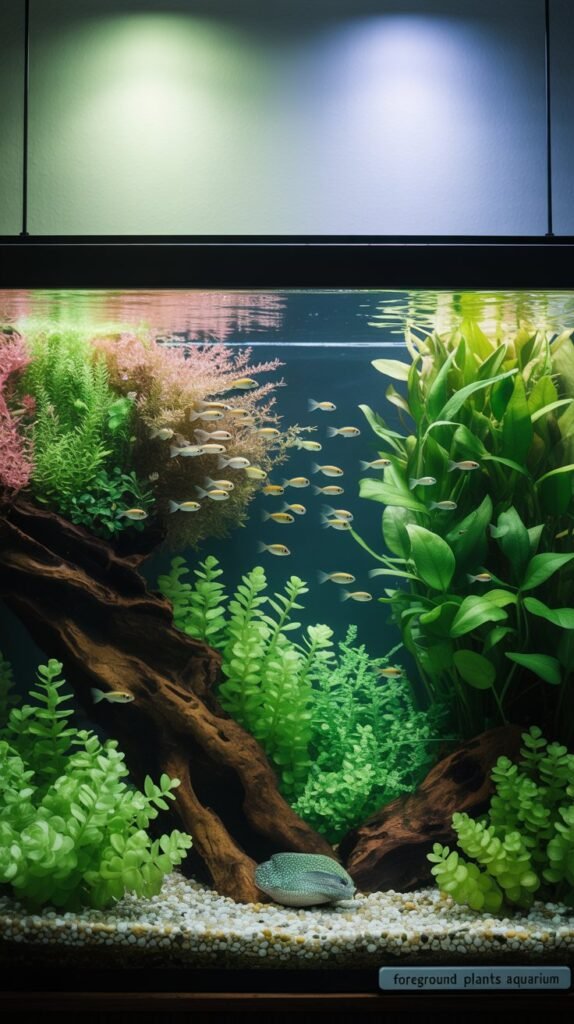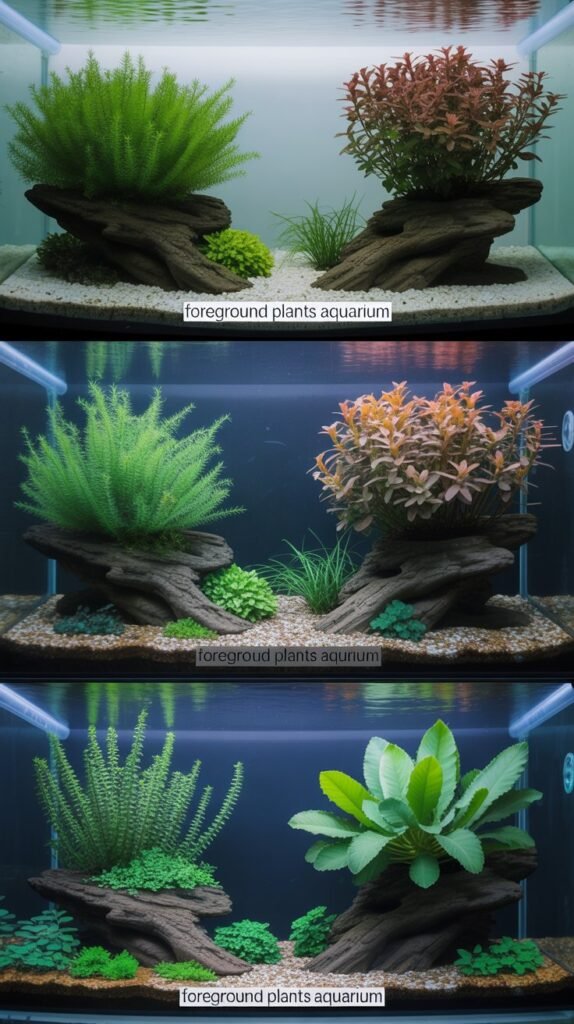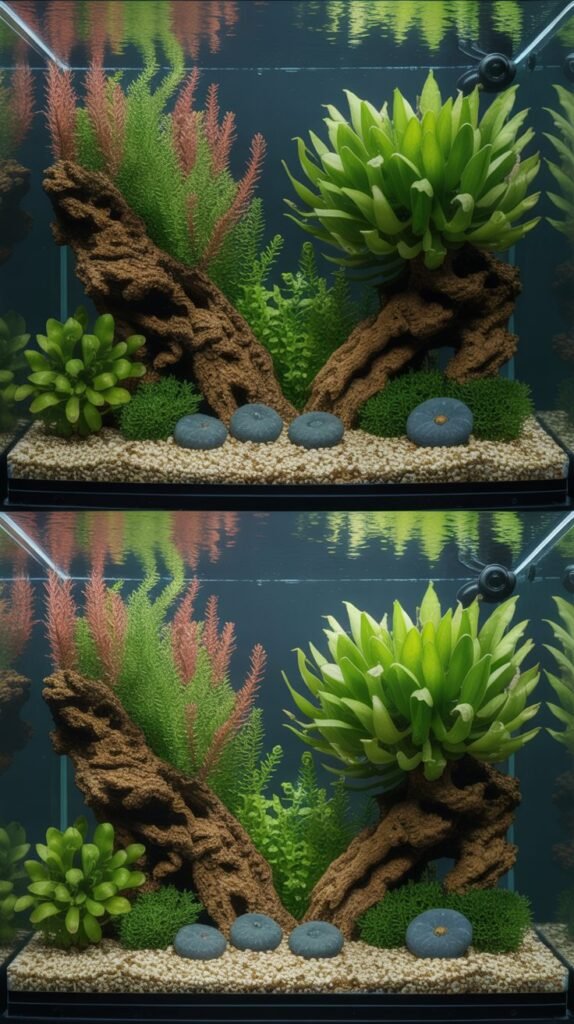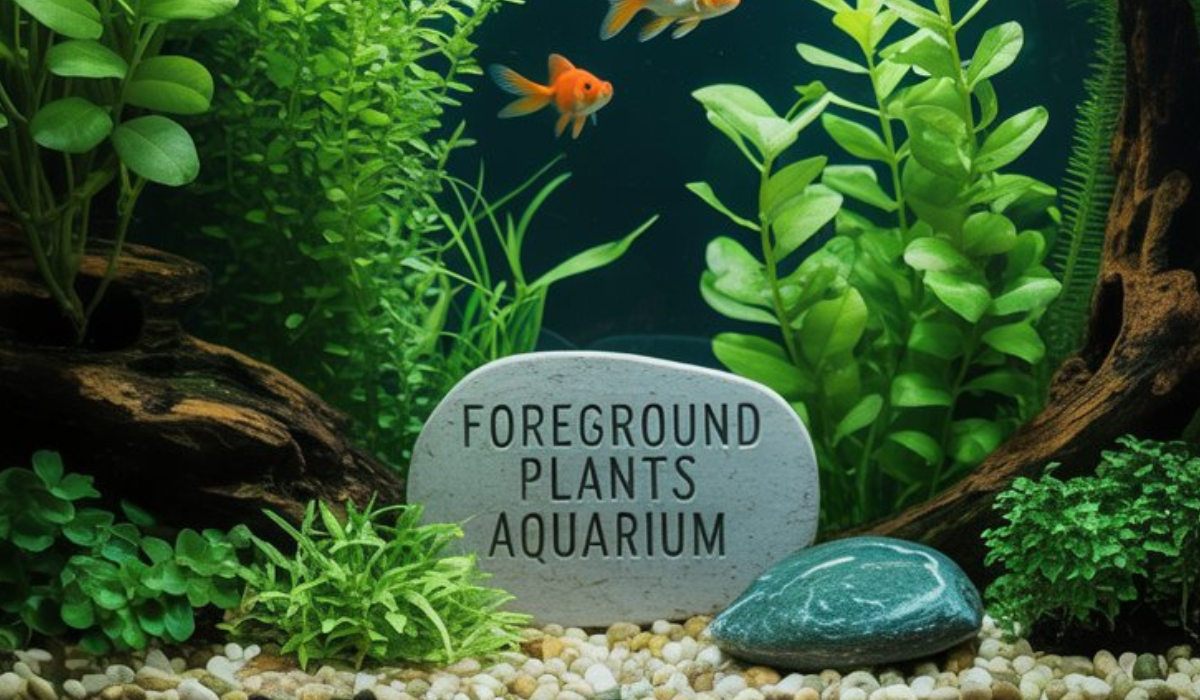Creating a lush, visually stunning aquarium is both an art and a science. One of the most important elements that elevate an aquarium’s beauty and balance is foreground plants. These small but impactful aquatic plants serve as the foundation of aquascaping, setting the stage for a vibrant underwater landscape. Whether you’re a beginner aquarist or an experienced hobbyist, choosing and maintaining foreground plants for aquariums can dramatically enhance your tank’s appeal and ecosystem.
In this comprehensive guide, we’ll explore everything you need to know about foreground aquarium plants — their types, benefits, care requirements, and the best species for different aquarium setups.
What Are Foreground Aquarium Plants?
Foreground plants, also known as carpeting plants, are short aquatic plants that grow close to the substrate (the bottom layer of your tank). Their primary purpose is to cover the aquarium floor, creating a lush green carpet or small decorative clusters that add texture, depth, and balance to your aquascape.
These plants typically range from 1 to 4 inches in height, making them perfect for the front section of the tank. They serve as a visual anchor, giving your aquarium a natural and layered look — similar to grass or moss on a forest floor.
Why Foreground Plants Are Important in Aquariums

Foreground plants do more than just enhance aesthetics. They play several crucial roles in maintaining a healthy aquatic environment.
1. Improve Water Quality
Foreground plants absorb nitrates, ammonia, and other toxins from the water, helping maintain stable water chemistry and keeping fish healthy.
2. Provide Shelter and Comfort
Many small fish and shrimp use these plants as hiding spots. This reduces stress and encourages natural behavior, especially for shy or young species.
3. Prevent Algae Growth
By absorbing nutrients that algae feed on, foreground plants compete with algae, reducing its growth and keeping the tank clean.
4. Enhance Aquascape Aesthetics
Foreground plants create a natural transition from the front to the back of the tank, enhancing depth and visual harmony. They are essential for professional aquascaping designs like Iwagumi and Nature Aquariums.
5. Support Microorganism Growth
They provide a surface for beneficial bacteria to colonize, which contributes to a stable biological filtration system.
Factors to Consider Before Choosing Foreground Plants
Before you rush to fill your aquarium with foreground plants, consider these key factors to ensure their healthy growth and compatibility with your tank.
1. Tank Size
Smaller tanks (below 20 gallons) benefit from compact and slow-growing plants, while larger tanks can accommodate dense carpet-forming species.
2. Lighting Conditions
Most foreground plants require moderate to high lighting to thrive. Insufficient light may cause slow growth or yellowing leaves.
3. CO₂ Injection
Many carpeting plants, especially the dense and vibrant ones, need CO₂ supplementation for optimal growth and color.
4. Substrate Type
A nutrient-rich substrate is crucial. Options like aqua soil, sand, or gravel work well, depending on the plant species.
5. Water Parameters
Each plant has preferred pH, hardness, and temperature ranges. Maintaining stable water conditions ensures steady growth.
Types of Foreground Aquarium Plants

Foreground plants come in several forms — from grass-like carpets to mosses and low-lying clusters. Here are the main categories:
1. Carpeting Plants
These plants spread horizontally, forming lush green carpets across the substrate.
Examples:
- Hemianthus callitrichoides (Dwarf Baby Tears)
- Glossostigma elatinoides (Glosso)
- Eleocharis parvula (Dwarf Hairgrass)
2. Rosette or Cluster Plants
Short plants that grow in compact clusters, adding volume and variety to the foreground.
Examples:
- Cryptocoryne parva
- Sagittaria subulata (Dwarf Sagittaria)
3. Moss and Creeping Plants
Ideal for beginners, mosses attach easily to rocks or driftwood and grow under low light.
Examples:
- Java Moss (Taxiphyllum barbieri)
- Christmas Moss (Vesicularia montagnei)
Top 10 Best Foreground Aquarium Plants
Let’s explore the most popular and effective foreground plants for aquariums — perfect for creating a natural, green underwater carpet.
1. Dwarf Hairgrass (Eleocharis parvula)
Overview:
A favorite among aquascapers, Dwarf Hairgrass forms a dense, grassy carpet that sways beautifully in the water current.
Requirements:
- Light: Medium to high
- CO₂: Recommended
- Temperature: 68–82°F
- pH: 6.5–7.5
- Growth Rate: Moderate
Tip: Trim regularly to encourage horizontal spreading.
2. Dwarf Baby Tears (Hemianthus callitrichoides)
Overview:
Known as one of the smallest aquarium plants, Dwarf Baby Tears create a lush, bright green mat. It’s visually stunning but requires high maintenance.
Requirements:
- Light: High
- CO₂: Essential
- Temperature: 70–82°F
- pH: 5.0–7.5
Tip: Plant in small clumps to encourage even spreading.
3. Monte Carlo (Micranthemum tweediei)
Overview:
A low-maintenance alternative to Dwarf Baby Tears, Monte Carlo is easier to grow and just as beautiful.
Requirements:
- Light: Medium to high
- CO₂: Recommended
- Temperature: 68–78°F
- pH: 6.0–7.5
Tip: Great choice for beginners seeking a vibrant carpet.
4. Glossostigma elatinoides
Overview:
One of the classic foreground plants for aquascapes, “Glosso” is ideal for creating a dense, vibrant green carpet.
Requirements:
- Light: High
- CO₂: Essential
- Temperature: 72–82°F
- pH: 6.0–7.5
Tip: Requires regular trimming and nutrient-rich substrate.
5. Cryptocoryne parva

Overview:
This slow-growing, low-light tolerant plant is perfect for low-tech tanks and beginners.
Requirements:
- Light: Low to medium
- CO₂: Not required
- Temperature: 72–82°F
- pH: 6.0–7.5
Tip: Patience is key — it grows slowly but steadily.
6. Marsilea hirsuta
Overview:
Resembling small clover leaves, Marsilea is a hardy and versatile foreground plant that adapts to different tank setups.
Requirements:
- Light: Low to high
- CO₂: Optional
- Temperature: 68–82°F
- pH: 6.0–7.5
Tip: In high light, it stays short and compact.
7. Staurogyne repens
Overview:
A robust plant with bright green leaves, perfect for adding texture to the foreground and midground.
Requirements:
- Light: Medium to high
- CO₂: Recommended
- Temperature: 68–82°F
- pH: 6.0–8.0
Tip: Trim the tops to encourage bushy growth.
8. Sagittaria subulata (Dwarf Sagittaria)
Overview:
A hardy plant that looks like miniature Vallisneria, suitable for both beginners and experienced aquarists.
Requirements:
- Light: Medium
- CO₂: Not required
- Temperature: 72–82°F
- pH: 6.5–7.5
Tip: Propagates easily through runners.
9. Java Moss (Taxiphyllum barbieri)
Overview:
One of the easiest foreground plants to grow, ideal for low-light and low-tech setups.
Requirements:
- Light: Low
- CO₂: Optional
- Temperature: 70–82°F
- pH: 6.0–7.5
Tip: Attach to rocks or driftwood for natural effect.
10. Christmas Moss (Vesicularia montagnei)
Overview:
Known for its dense, tree-like pattern, this moss brings a unique visual texture to your aquarium.
Requirements:
- Light: Low to medium
- CO₂: Optional
- Temperature: 68–78°F
- pH: 6.0–7.5
Tip: Trim regularly to maintain shape and prevent decay.
Planting Tips for Foreground Aquarium Plants
Getting your foreground plants to thrive requires the right planting and care techniques.
- Use Fine Substrate:
Fine-grained substrates help roots anchor easily and spread efficiently. - Plant in Small Portions:
Divide plants into small clumps or plugs before planting to ensure even coverage. - Use Aquascaping Tweezers:
Helps in precision planting without disturbing the substrate. - Provide Adequate Light:
8–10 hours of consistent light is ideal for healthy growth. - Add Fertilizers:
Use root tabs or liquid fertilizers rich in iron and micronutrients. - Maintain Water Flow:
Moderate flow helps distribute CO₂ and nutrients evenly.
Foreground Plant Maintenance and Care
To maintain lush growth, follow these regular maintenance steps:
- Trim frequently: Prevents overcrowding and promotes horizontal spreading.
- Monitor algae growth: Maintain nutrient balance and light duration.
- Regular water changes: 20–30% weekly helps maintain clear water.
- CO₂ monitoring: Ensure optimal CO₂ levels if using an injection system.
- Remove dead leaves: Prevents decay and nutrient spikes.
Designing with Foreground Plants: Aquascaping Ideas
Foreground plants play a major role in aquascaping design. Here are a few inspiring styles:
1. Iwagumi Style
A minimalist Japanese design emphasizing stones and symmetry. Use Dwarf Hairgrass or Monte Carlo for clean carpeting.
2. Nature Aquarium
Combines different plant types and textures for a natural landscape. Cryptocoryne parva and Staurogyne repens work beautifully here.
3. Dutch Style
Focuses on colorful plant arrangements and layers. Use Glossostigma or Marsilea as vibrant borders.
4. Jungle Style
Dense and wild layouts that mimic natural riverbeds — Java Moss and Christmas Moss are perfect for this.
Best Tank Mates for Foreground Plants
Foreground plants thrive best with peaceful, plant-friendly tank mates:
- Tetras (Neon, Cardinal, Ember)
- Guppies
- Shrimp (Cherry, Amano)
- Otocinclus Catfish
- Snails (Nerite, Mystery)
Avoid plant-eating species like Goldfish or Cichlids, as they can uproot or eat delicate foreground plants.
Common Problems and Solutions
| Problem | Cause | Solution |
|---|---|---|
| Yellowing leaves | Nutrient deficiency | Add root tabs or liquid fertilizer |
| Slow growth | Low light or CO₂ | Increase lighting and consider CO₂ injection |
| Algae overgrowth | Too much light or nutrients | Reduce light duration, balance fertilization |
| Melting plants | Sudden water changes | Maintain stable parameters and acclimate plants |
Foreground Plants for Low-Tech Aquariums
If you don’t want to use CO₂ injection or high lighting, these plants are great for low-tech setups:
- Java Moss
- Cryptocoryne parva
- Marsilea hirsuta
- Sagittaria subulata
- Staurogyne repens
These hardy plants adapt well to minimal intervention and still provide a lush, green look.
Final Thoughts
Foreground plants are the foundation of a beautiful aquascape. They bring depth, texture, and a natural look to your aquarium while contributing to a balanced ecosystem. Whether you’re creating a minimalist Iwagumi layout or a thriving nature-style aquascape, choosing the right foreground plants for your aquarium makes all the difference.
By selecting suitable species, maintaining proper lighting, and ensuring stable water parameters, you can enjoy a vibrant underwater garden that both you and your aquatic pets will love.
FAQs About Foreground Plants Aquarium
Q1: Do foreground aquarium plants need CO₂?
A: Not all of them. While some plants like Dwarf Baby Tears and Glosso need CO₂, others like Cryptocoryne parva and Java Moss grow fine without it.
Q2: How long do foreground plants take to carpet?
A: Depending on species and tank conditions, it can take 4–10 weeks for most foreground plants to fully carpet the substrate.
Q3: Can I grow foreground plants in gravel?
A: Yes, but they prefer fine-grained or nutrient-rich substrates. You can supplement with root tabs for better results.
Q4: How much light do foreground plants need?
A: Most require moderate to high lighting for optimal growth, typically 8–10 hours daily.
Q5: Which foreground plants are best for beginners?
A: Easy-to-grow options include Monte Carlo, Marsilea hirsuta, Cryptocoryne parva, and Java Moss.
Q6: Do foreground plants need fertilizer?
A: Yes, using liquid or root fertilizers ensures they get essential nutrients like iron and potassium.
Q7: How can I stop foreground plants from floating up?
A: Plant them deeply using aquascaping tweezers and press the substrate gently around the roots.
Q8: Can I mix different foreground plants together?
A: Absolutely! Combining textures like Hairgrass and Monte Carlo creates a dynamic, natural look.

